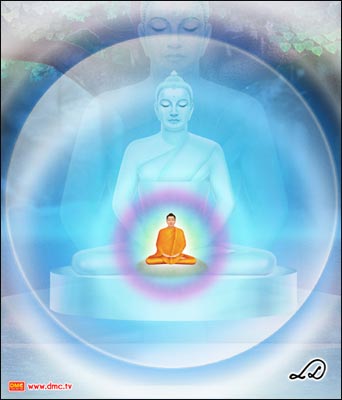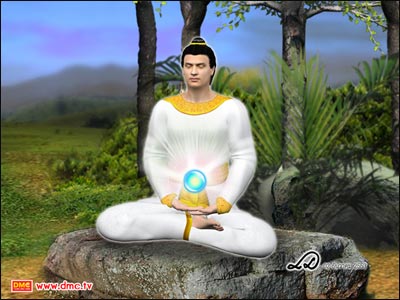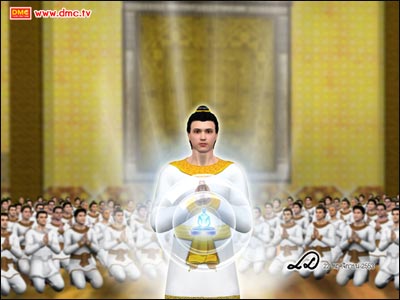The Noble Truth of the Path to
the Cessation of Suffering # 1
The Buddha taught that Right View is a fiercely accurate understanding of life
The final of the four Truths of the Noble Ones taught by the Lord Buddha was the Path to the Cessation of Suffering (or the Noble Eightfold Path) – the way to extinguish all suffering and attain Nirvana. This is the path always followed by the Noble Ones (amongst whom the Lord Buddha was supreme) because this path is the only way by which the defilements and desires can be definitively overcome on the way to the final destination of Nirvana.
The Noble Eightfold Path
The Noble Eightfold Path comprises:
1. Right View [Samma Ditthi]
2. Right Intention [Sanna Sankappa]
3. Right Speech [Samma Vaca]
4. Right Action [Samma Kammanta]
5. Right Livelihood [Samma Ajiva]
6. Right Effort [Samma Vayama]
7. Right Mindfulness [Samma Sati]
8. Right Concentration [Samma Samadhi]
Right Intention refers to the wholesome thoughts or intentions which leads us to be generous
1. Right View
The Buddha taught that Right View is a fiercely accurate understanding of life and the world based on the benchmark of Nirvana, a thorough understanding of all four Noble Truths, and practice for the removal of ignorance and craving.
2. Right Intention
Right Intention refers to the wholesome thoughts or intentions which leads us to be generous, keep the Precepts and meditate. It is intention that is free from vengefulness or thought to harm others. On the contrary it is intentionfilled with the compassion of the four Divine Abidings [brahmavihara]: loving-kindness, compassion, sympathetic joy and equanimity.
3. Right Speech
Right Speech is what remains when we abstain from speaking in any of the following four ways:
Telling lies [musavada]: We must abstain from telling lies Divisive Speech [pisunavaca]: We must abstain from speech that creates disharmony or brings suffering, anger or damage to others;
Harsh Speech [pharusavaca]: We must abstain from swearing and insulting others;
Idle Chatter [samphappalavaca]: We must abstain from superfluous speech or purposeless speech.
4. Right Action
Right Action is what remains when we abstain from doing any of the following three sorts of actions:
Killing living beings [panatipata];
Stealing [adinnadana]: Taking that which is not given;
Committing adultery [kamesumicchacara]: abstaining from sexual relations outside marriage.
The seeing and consideration of the bodies within the body
continuously in this way is what we call Mindfulness of Body in the Body.
5. Right Livelihood
The Lord Buddha taught his monks to avoid earning their living in a dishonest way –especially trying to impress supporters into making offerings by claiming mental attainments not yet reached, being a witch doctor or an alternative doctor. Furthermore monks should live by almsround, not by begging nor making requests of strangers nor investing money –monks should live in an honest way in the ways recommended by the Noble Ones.
6. Right Effort
Right Effort is composed of the Four Foundations of Effort, namely:
Avoidance of evils not yet done [samvara-padhana];
Abandonment of evils already done [pahana-padhana];
Development of virtues not yet done [bhavana-padhana];
Maintainance of virtues already mastered [anurakkhanapadhana].
7. Right Mindfulness
The Four Foundations of Mindfulness comprise:
Mindfulness of the body [kayanupassanasatipatthana];
Mindfulness of the feelings [vedananupassanasatipatthana];
Mindfulness of the mind [cittanupassanasatipatthana];
Mindfulness of mental phenomena [dhammanupassanasatipatthana].
7.1 Mindfulness of the Body in the Body
Mindfulness of the body means being able to see and consider one’s inner bodies continuously – to see the various inner bodies that are nested in inner dimensions of our physical human body, all the way from our subtle human body (also called the ‘astral body’ or ‘dream body’) all the way up to the various bodies of enlightenment.
Mindfulness of the Body in the Body
By settling their attention to the centre of the body (the seventh base of the mind). When the mind is firmly settled and is properly adjusted (brought to a standstill) a bright sphere will arise at the centre of the body. This sphere is known as the Pathama Magga Sphere [Dhammanupassanasatipatthana sphere]. Bringing your attention at the point at the centre of the sphere, it will enlarge until it is so large that its edges disappear over the horizon. A new sphere brighter and clearer than the last will appear at the centre which is called the sphere of self-discipline. In the same way, the sphere of concentration, the sphere of wisdom, the sphere of liberation, the sphere of knowledge and vision of liberation can be attained in sequence. If one stops one’s mind at the point at the centre of the sphere, it will enlarge until it is so large that its edges disappear over the horizon allowing one to see the subtle human body inside – an inner body that looks the same as the physical body, but more radiant. On attaining the subtle human body, the realization will arise in the mind that “There is more to life than just the physical body. The physical body is just the outermost layer,” and “life doesn’t finish at the grave because there is still life inside, independent of the physical body.” The outer body will suddenly essm like no more than a house where one resides temporarily. Once one has seen the physical body (for the first time) according to its reality, one will be able to ‘let go ‘ of it –allowing the mind to go deeper and become unified with the subtle material body. One will have no more feeling of sentimentality for the physical body nor any of the other things associated with it such as children, husband, wife or wealth. As the majority of sorts of suffering concerns material things, having attained the subtle human body, the mind, being unified with the subtle human body, is safely with drawn beyond the reach of that suffering.
The reason why most people get upset about things is because they have not yet managed to attain the subtle human body-and consequently are still attached to their body and their possessions. Even thought hey might try to ration aliwx intellectually according to the teaching of the Buddha and try to convince themselves that” All things are of a nature of impermanence, suffering and not-self-they arise, exist for a time and then decay,” however, it is no more than a conceptualization. Such a thought might seem to console one for a while, but it doesn’t make the suffering go away. Such thinking might even increase one’s suffering because it will only increase one’s disappointment that one can’t manage to make the suffering go away. It cannot remove the source of the suffering at its roots by the method of transcending [samuccheda-virati]. This is the reason why the Lord Buddha taught us to practice by meditation to the point where we can see and consider the bodies within the body.
Once one has attained the subtle human body, having significantly reduced one’s suffering by loosening the fetters of ‘clinging’ [upadana], there will be a feeling of refreshednees, joy and happiness which arises from within the mind –giving the meditatior the inspiration they need for the mind to enter yet deeper on the central axis – and the deeper the meditator can go, the stronger will be the feeling of such inner happiness.
Mindfulness of the body means being able to see and consider one’s inner bodies continuously
The nature of all the inner bodies is to have their centre all aligned with the centre of the physical body (seventh base of the mind). Thus, simply by settling the mind further at the centre of the body, in the same way as described earlier, in entering the centre of the Pathama Magga Sphere, successive inner bodies can be attained, going further inside the subtle human body the angelic body, the subtle angelic body, the form-Brahma body, the subtle form-Brahma body, the formless Brahma-body, the subtle formless Brahma-body and eventually the body of enlightenment [Dhammakaya]-each with their own life and mind.
The mind of the Dhammakaya is endowed with special knowledge allowing the meditator to see that the various bodies, all the way from the human body to the subtle formless Brahma-body are all composed of the Five Aggregates [khandha] and are hence subject to the influence of the Three Signs [dukkham] and not –self [anatta]. None of these bodies transcend the mundane level if existence they are worldly [lokiya]. They are all still in the vicious circle of causation between defilements [kilesa], action [kamma] and retribution [vipaka].
By contrast, the further up the scale of purity of the various bodies of enlightenment, the more radiant and blissful the mind becomes. The bodies of enlightenment are transcendental [lokuttara] and are beyond the influence of the Three Signs because they are not made of mundane Aggregates but transcendental Aggregates [dhammakhandha]. The knowledge contained in the bodies of enlightenment which allows the meditator to consider the Three Signs in the mundane bodies, alsom allws them to consider the Four Noble Truths. This part of the practice is indeed the Noble Path which leads the meditator to the transcendental and eternal Noble Fruition they are aiming for.
It is for this reason that the Lord Buddha advocated his monks to cultivate transcendental know ledge in order to put themselves beyond the reach of sensuality [kama], unwhole someness [akusaladhamma], to eradicate False View [miccha ditthi]. Attaining the First Absorption [pathama jhana], they will be endowed with applicationof mind [vitaka], continued application of mind [vicara], joy [piti], happiness [sukha] and one-pointedness [ekaggata] (see also page 130 off.) The seeing and consideration of the bodies within the body continuously in this way is what we call Mindfulness of Body in the Body.
Meditation - Related Articles
" />
" />
" />
" />
" />
" />
" />
" />
" />
" />
" />
" />
" />










